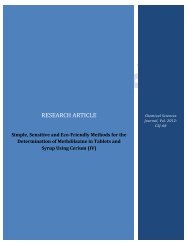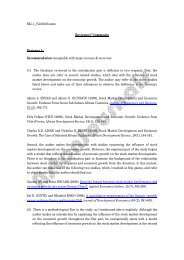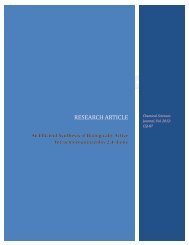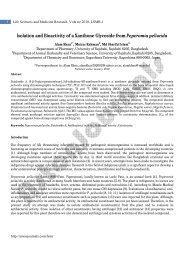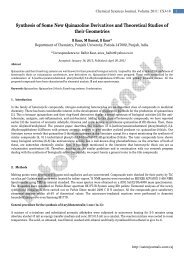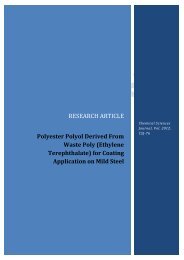Coping with Floods in the Savannah Region of Ghana - OMICS ...
Coping with Floods in the Savannah Region of Ghana - OMICS ...
Coping with Floods in the Savannah Region of Ghana - OMICS ...
- No tags were found...
Create successful ePaper yourself
Turn your PDF publications into a flip-book with our unique Google optimized e-Paper software.
4 Research Articledata collection <strong>in</strong>struments used for <strong>the</strong> research <strong>in</strong>cludes documents, journals, newspapers and alsoreports from National Disaster Management Organisation (NADMO), and Central Gonja District Assembly.Reports from NADMO were used to get data on available flood statistics. Ra<strong>in</strong>fall figures were obta<strong>in</strong>ed from<strong>the</strong> <strong>Ghana</strong> Meteorological Agency. This was to support <strong>the</strong> argument that physical characteristics such asra<strong>in</strong>fall are not <strong>the</strong> sole causes <strong>of</strong> vulnerability to hazards. Aga<strong>in</strong>, reports were taken from <strong>the</strong> Central GonjaDistrict Assembly on <strong>the</strong> backgrounds <strong>of</strong> <strong>the</strong> communities.Structured <strong>in</strong>terviews were used for <strong>the</strong> head <strong>of</strong> <strong>in</strong>stitutions. Institutions which were <strong>in</strong>terviewed<strong>in</strong>clude <strong>the</strong> Central Gonja District Assembly, National Disaster Management Organization and M<strong>in</strong>istry <strong>of</strong>Food and Agriculture. Structured <strong>in</strong>terviews were used to seek op<strong>in</strong>ion <strong>of</strong> <strong>the</strong> <strong>in</strong>stitutions on <strong>the</strong> mitigationstrategies provided by <strong>the</strong>m, causes <strong>of</strong> flood<strong>in</strong>g and vulnerability, access to key assets and why recovery andnot relocation has been <strong>the</strong> choice <strong>of</strong> <strong>the</strong> people. Questionnaires were used for heads <strong>of</strong> households. Thequestionnaires were divided <strong>in</strong>to sections which <strong>in</strong>cluded socio-demographic characteristics <strong>of</strong> respondents,build<strong>in</strong>g structures, flood experiences, recovery and assets <strong>of</strong> respondents.Focus group discussions were used for community elders. Both women and men were <strong>of</strong> differentethnic groups and had stayed <strong>in</strong> <strong>the</strong> community for more than 30 years. Focus group discussions were usedto provide more <strong>in</strong>formation on flood<strong>in</strong>g. The discussions were used to generate data on changes <strong>in</strong> <strong>the</strong>occurrence <strong>of</strong> flood<strong>in</strong>g, community assets, access and how <strong>the</strong>y have changed over time. We had two differentdiscussions at Buipe. The discussions were carried out on <strong>the</strong> 14 October 2011 but at different timesfor both men and women. The focus group at Buipe constituted 15 peoples (7 men and 8 women). The discussionslasted for about 138 m<strong>in</strong>utes (65 m<strong>in</strong>utes for men and 73 m<strong>in</strong>utes for women). In Yapei <strong>the</strong> focusgroup constituted 14 peoples (7 men and 7 women). The discussions lasted for 135 m<strong>in</strong>utes <strong>in</strong> Yapei (65m<strong>in</strong>utes for women and 70 m<strong>in</strong>utes for men). Data was analysed us<strong>in</strong>g <strong>the</strong> Statistical Package and ServiceSolution (SPSS). In test<strong>in</strong>g <strong>the</strong> hypo<strong>the</strong>ses, <strong>in</strong>ferential statistics were used on mak<strong>in</strong>g <strong>in</strong>ferences about <strong>the</strong>characteristics <strong>of</strong> populations based on sample data. The chi square test was used for hypo<strong>the</strong>sis which<strong>in</strong>volved two categorical variables. The hypo<strong>the</strong>ses tested were gender which does not <strong>in</strong>fluence access tokey assets. Age does not <strong>in</strong>fluence access to key assets.3. Results and DiscussionHuman populations have become more vulnerable <strong>in</strong> recent years, despite <strong>the</strong> numerous steps be<strong>in</strong>g takento reduce disasters [7]. Many have <strong>the</strong>refore considered vulnerability to environmental hazards not as aresult <strong>of</strong> <strong>the</strong> physical location <strong>of</strong> people <strong>in</strong> many precarious areas but as a result <strong>of</strong> lack <strong>of</strong> access to keyassets such as education, land, loans, help and secure hous<strong>in</strong>g. People’s vulnerability to hazards is generatedby social, economic and political processes [8]. These processes <strong>in</strong>fluence how hazards affect people<strong>in</strong> vary<strong>in</strong>g ways and different <strong>in</strong>tensities [8]. This section presents <strong>the</strong> f<strong>in</strong>d<strong>in</strong>gs from <strong>the</strong> study and showshow demographic characteristics <strong>of</strong> <strong>in</strong>dividuals or groups affect <strong>the</strong>ir ability to access key assets and how itaffects <strong>the</strong>ir ability to cope <strong>with</strong> hazards.Asset has been variously def<strong>in</strong>ed by different people. Assets have been identified as stock <strong>of</strong> f<strong>in</strong>ancial,human, natural or social resources that can be acquired, developed, improved and transferred acrossgenerations. It generates flows or consumption, as well as additional stock [9]. Assets have been def<strong>in</strong>ed byBebb<strong>in</strong>gton [10] as ‘not simply resources that people use to build livelihoods, but <strong>the</strong>y give <strong>the</strong>m <strong>the</strong> capabilityto be and act’. In recent times, assets or capital endowment <strong>in</strong>cludes both tangible and <strong>in</strong>tangible assets[11, 12]. These <strong>in</strong>clude physical, f<strong>in</strong>ancial, human capital, social and natural capital.All <strong>the</strong> five assets were used <strong>in</strong> <strong>the</strong> study, <strong>the</strong>se <strong>in</strong>clude land (natural), education (human), loans(f<strong>in</strong>ancial), secure hous<strong>in</strong>g (physical) and assistance (social) from friends, relatives, government and nongovernmentalagencies. We used <strong>the</strong>se assets because <strong>the</strong>y can help residents affected by floods to anticipate,resist and recover from flood impacts. Assets such as land and secured houses can be used forproductive purposes. Also <strong>the</strong>y represent a store <strong>of</strong> value that can be turned <strong>in</strong>to cash when needed.Access to education can help <strong>in</strong>dividuals understand warn<strong>in</strong>g <strong>in</strong>formation, ga<strong>in</strong> knowledge and skills andalso employment <strong>in</strong> <strong>the</strong> formal sector which helps <strong>in</strong>dividuals to <strong>with</strong>stand <strong>the</strong> impacts <strong>of</strong> floods. Aga<strong>in</strong>f<strong>in</strong>ancial assets such as loan help <strong>in</strong> <strong>the</strong> speedy recovery <strong>of</strong> disaster victims. This is because it can be usedto restore properties that have been destroyed. Recent studies suggest that assets are important for reduc<strong>in</strong>gpoverty, and cushion<strong>in</strong>g risk and vulnerability from natural disasters, illness or f<strong>in</strong>ancial crises [13]. It isnow widely recognized that ownership and control over assets such as land and hous<strong>in</strong>g provide direct andhttp://astonjournals.com/assj
Arts and Social Sciences Journal, Vol. 2013: ASSJ-615<strong>in</strong>direct benefits to <strong>in</strong>dividuals and households, <strong>in</strong>clud<strong>in</strong>g a secure place to live, <strong>the</strong> means <strong>of</strong> a livelihood,protection dur<strong>in</strong>g emergencies, and collateral for credit that can be used for <strong>in</strong>vestment or consumption [13].Some socio-demographic characteristics have been identified by some researchers to hav<strong>in</strong>g <strong>in</strong>fluencedvulnerability to hazards. These <strong>in</strong>clude age and gender. These characteristics <strong>in</strong>fluence access to keyassets and affect people’s vulnerability to environmental hazards. Aga<strong>in</strong> socio-demographic characteristicslike gender could prevent one’s ability to cope from <strong>the</strong> impacts <strong>of</strong> hazards. For <strong>in</strong>stance, studies have shownthat women and children are 14 times more likely to die than men dur<strong>in</strong>g a disaster. In <strong>the</strong> 1991 cyclonedisasters which killed 140,000 <strong>in</strong> Bangladesh, 90% <strong>of</strong> victims were women [14]. In Sri Lanka, males werema<strong>in</strong>ly taught swimm<strong>in</strong>g and tree climb<strong>in</strong>g, which helped <strong>the</strong>m survive and cope better than females when<strong>the</strong> waves <strong>of</strong> <strong>the</strong> tsunami hit. Social prejudice keeps girls and women from learn<strong>in</strong>g to swim, which severelyreduces <strong>the</strong>ir chances <strong>of</strong> survival <strong>in</strong> flood<strong>in</strong>g disasters [15]. Also, it has been concluded that, more womenthan men work <strong>in</strong> <strong>the</strong> <strong>in</strong>formal sector and <strong>in</strong> small enterprises. These sectors are <strong>of</strong>ten <strong>the</strong> worst hit andleast able to recover from <strong>the</strong> effects <strong>of</strong> disasters, due to lack <strong>of</strong> capital, and limited access to credit and<strong>in</strong>formation, among o<strong>the</strong>r obstacles [16].3.1. Gender and access to human, natural, social, f<strong>in</strong>ancial and physical capitalAt <strong>the</strong> urban centre, 65.1% <strong>of</strong> <strong>the</strong> samples were males while females <strong>in</strong> <strong>the</strong> sample represented 34.9%.At <strong>the</strong> rural settlement, males constituted 83.08% <strong>of</strong> <strong>the</strong> sample and females constituted 16.92%. In bothareas <strong>of</strong> research, <strong>the</strong>re were more households headed by men than women. This could be as a result <strong>of</strong> <strong>the</strong><strong>Ghana</strong>ian traditional system, where men are recognized as <strong>the</strong> head <strong>of</strong> households. Aga<strong>in</strong> this could alsobe a sampl<strong>in</strong>g error. However, Buipe has more females as household heads than Yapei. Most <strong>of</strong> <strong>the</strong> femaleswho were household heads were widowed or divorced.In <strong>the</strong> two study areas, females appeared to be more disadvantaged <strong>in</strong> asset ownership than men.Limited exist<strong>in</strong>g <strong>in</strong>formation shows that women <strong>in</strong> many countries are far less likely than men to have ownershipor control <strong>of</strong> productive assets. In addition, women may not receive <strong>the</strong> benefits <strong>of</strong> assets held bymen, even when <strong>the</strong>y live <strong>in</strong> <strong>the</strong> same household [17]. Beyond empower<strong>in</strong>g women, productive assets playan important role <strong>in</strong> reduc<strong>in</strong>g poverty [13]. A key element <strong>in</strong> poverty reduction is streng<strong>the</strong>n<strong>in</strong>g <strong>the</strong> ability <strong>of</strong>households and <strong>in</strong>dividuals to respond to aggregate shocks, such as droughts or floods, as well as idiosyncraticshocks, such as illness or divorce [13]. The possession <strong>of</strong> assets helps households and <strong>in</strong>dividuals tocope <strong>with</strong> vulnerability and avoid impoverishment [18, 19]. When people have more assets, <strong>the</strong>y experienceless vulnerability and <strong>in</strong>security <strong>in</strong> <strong>the</strong> face <strong>of</strong> risks; conversely, <strong>the</strong> more assets are eroded, <strong>the</strong> greater ispeople’s vulnerability [20].Assets help flood victims anticipate, resist and recover from floods. However societal processessometimes affect people’s ability to access <strong>the</strong>se key assets. For <strong>in</strong>stance, Government policy, social norms,<strong>in</strong>tra-family arrangements, and <strong>the</strong> market determ<strong>in</strong>e ownership and accumulation <strong>of</strong> assets. Gender biases<strong>in</strong> each <strong>of</strong> <strong>the</strong>se different <strong>in</strong>stitutions and practices limit women’s ability to obta<strong>in</strong> and keep assets [13].Table 1 below shows gender and access to all five assets <strong>in</strong> both study areas. In <strong>the</strong> study at <strong>the</strong> urban centre,32% <strong>of</strong> <strong>the</strong> sample had formal education <strong>with</strong> 27% as males (10% had primary education, 10% had basiceducation, 4% had secondary education and 3% had tertiary education) and 5% as females (3% had primaryeducation and 2% had basic education). However, <strong>in</strong> <strong>the</strong> rural centre only 14% <strong>of</strong> <strong>the</strong> males <strong>in</strong> <strong>the</strong> samplehad access to formal education. Out <strong>of</strong> this percentage, 5% had primary education, 7% had basic educationand 2% had secondary education. None <strong>of</strong> <strong>the</strong> females <strong>in</strong> <strong>the</strong> sample had access to formal education.Even though more men have been educated than women <strong>in</strong> <strong>the</strong> communities, <strong>the</strong> number is not significantespecially at Yapei.Table 1: Gender and access to education, land, social network, loans and houses at Buipe and Yapei.AssetsEducation (%) Land (%) Help (%) Loans (%) Hous<strong>in</strong>g (%)Gender Buipe Yapei Buipe Yapei Buipe Yapei Buipe Yapei Buipe YapeiMales 27 14 33 44 18 16 29 6 39 80Females 5 0 9 5 7 3 18 0 24 15http://astonjournals.com/assj
6 Research ArticleLand is described as a critical productive asset for <strong>the</strong> poor <strong>in</strong> rural communities while <strong>in</strong> urbanareas land for shelter is also a critical productive asset [10, 21–26]. However <strong>in</strong> <strong>the</strong> survey areas land wasused as a productive asset. Land was used for farm<strong>in</strong>g purposes whiles o<strong>the</strong>rs used it as an asset which<strong>the</strong>y could rely on <strong>in</strong> times <strong>of</strong> hazards. From <strong>the</strong> study, we found out that, 33% <strong>of</strong> males at Buipe and 44% <strong>of</strong>males at Yapei <strong>in</strong> <strong>the</strong> sample owned land. Also 9% <strong>of</strong> <strong>the</strong> females at Buipe and 5% <strong>of</strong> <strong>the</strong> females at Yapeiowned land. The percentage <strong>of</strong> females who owned land is smaller than <strong>the</strong> percentage <strong>of</strong> males who ownedland. Studies carried out <strong>in</strong> o<strong>the</strong>r African countries showed that percentages <strong>of</strong> women who owned land werenot significant. In Uganda only 7% <strong>of</strong> women own land <strong>the</strong>mselves [27]. Doss [28] found that women ownedland <strong>in</strong> only 10% <strong>of</strong> <strong>Ghana</strong>ian households while men owned land <strong>in</strong> 16–23%. This depended on <strong>the</strong> year <strong>of</strong><strong>the</strong> survey. Land as discussed earlier is a productive asset <strong>in</strong> <strong>the</strong> study areas. However <strong>in</strong> times <strong>of</strong> disasterslands were sold <strong>in</strong> order to recover from flood impacts. In both study areas percentage <strong>of</strong> women who ownedland was not significant. This affects <strong>the</strong>ir ability to recover from flood consequences. More males <strong>in</strong> <strong>the</strong>study areas were able to recover faster than females.F<strong>in</strong>ancial capital is becom<strong>in</strong>g central to <strong>the</strong> o<strong>the</strong>r forms <strong>of</strong> capital assets <strong>in</strong> <strong>the</strong> globalized world[29]. Access to f<strong>in</strong>ancial capital could enable flood victims to recover quickly from <strong>the</strong> impacts <strong>of</strong> floodss<strong>in</strong>ce it enables victims to restore all <strong>the</strong>ir losses. At <strong>the</strong> urban centre, 29% <strong>of</strong> males and 18% <strong>of</strong> femaleshad access to loans from f<strong>in</strong>ancial <strong>in</strong>stitutions whiles 6% <strong>of</strong> <strong>the</strong> sample at <strong>the</strong> rural centre be<strong>in</strong>g males hadaccess to loans not from f<strong>in</strong>ancial <strong>in</strong>stitutions but from friends and relatives. None <strong>of</strong> <strong>the</strong> females at Yapeireceived any form <strong>of</strong> loan. From <strong>the</strong> research, more females had access to loans than males <strong>in</strong> <strong>the</strong> urbancentre. This means that females had an advantage as regards to access to this asset than <strong>the</strong>ir male counterpart.However at Yapei, <strong>the</strong>re were no f<strong>in</strong>ancial <strong>in</strong>stitutions as at <strong>the</strong> time <strong>the</strong> data was collected. In afocus group discussion, one woman said “<strong>the</strong>re are no banks <strong>in</strong> this community so we don’t save and are noteven able to secure loans like those at Buipe. We used to save <strong>with</strong> some men who come around but <strong>the</strong>yhave run away <strong>with</strong> our monies. They took my GH¢ 300 away”. Access to f<strong>in</strong>ancial capital helps <strong>in</strong> recover<strong>in</strong>gfrom <strong>the</strong> impacts <strong>of</strong> floods. This is because f<strong>in</strong>ancial capital helps to restart bus<strong>in</strong>esses, lives and also toget all properties that were lost.Households are important adaptive <strong>in</strong>stitutions and act as safety nets <strong>in</strong> times <strong>of</strong> economic difficulty[30]. At Buipe and Yapei, households acted as safety nets for those whose houses were floodedand destroyed as some <strong>of</strong> <strong>the</strong>m packed <strong>the</strong>ir belong<strong>in</strong>gs and stayed <strong>with</strong> friends and families. Also accessto help enabled some respondents to anticipate and recover from flood consequences. Those who did notreceive help had to stay <strong>in</strong> schools, verandas, tents and abandoned structures. This affected <strong>the</strong> health <strong>of</strong>some respondents. With regards to social capital at Buipe 18% <strong>of</strong> males and 7% <strong>of</strong> females received helpfrom friends and relatives. However at <strong>the</strong> rural area, 16% <strong>of</strong> males and 3% <strong>of</strong> females received help dur<strong>in</strong>g<strong>the</strong> 2010 floods.Hous<strong>in</strong>g quality is an important <strong>in</strong>dicator <strong>of</strong> flood vulnerability [31]. For example, <strong>in</strong> his study, households<strong>in</strong> a grass-thatched house were perceived to be more vulnerable to floods than households <strong>in</strong> a stonehouse, whose hous<strong>in</strong>g structure represents high cop<strong>in</strong>g capacity and more resilience to flood hazards.Hous<strong>in</strong>g quality helps to resist <strong>the</strong> consequences <strong>of</strong> flood. In both communities, houses built <strong>of</strong> cementblocks were more resistant to floods than houses built <strong>of</strong> mud. Mud houses are not able to <strong>with</strong>stand <strong>the</strong>impacts <strong>of</strong> floods and easily collapse. At <strong>the</strong> urban centre, 39% <strong>of</strong> men owned and lived <strong>in</strong> <strong>the</strong>ir own houseswhiles 24% <strong>of</strong> women owned and lived <strong>in</strong> <strong>the</strong>ir own houses. Out <strong>of</strong> this percentage, 13% <strong>of</strong> <strong>the</strong> males and4% <strong>of</strong> females own houses built <strong>of</strong> cement blocks. At <strong>the</strong> rural centre, 80% <strong>of</strong> males and 15% <strong>of</strong> femalesown houses. Out <strong>of</strong> <strong>the</strong> percentage <strong>of</strong> males who own and lived <strong>in</strong> <strong>the</strong>ir houses only 6% had <strong>the</strong>ir housesbuilt <strong>of</strong> cement blocks. None <strong>of</strong> <strong>the</strong> females owned a house built <strong>of</strong> cement blocks. Houses built <strong>of</strong> mudwere destroyed dur<strong>in</strong>g <strong>the</strong> 2010 floods. Houses built <strong>of</strong> cement were able to <strong>with</strong>stand flood impacts. Thosewho owned houses built <strong>of</strong> cement were able to rent it out and made monies. This enabled <strong>the</strong>m to recoverfrom <strong>the</strong> flood impact, majority <strong>of</strong> who are males. Plates 1 and 2 show hous<strong>in</strong>g qualities <strong>in</strong> Buipe. A cementhouse has been able to <strong>with</strong>stand floods while <strong>the</strong> mud houses could not.To test for <strong>the</strong> level <strong>of</strong> significance between gender and access to assets, <strong>the</strong> chi square test wasused <strong>with</strong> a 5% confidence level. At Buipe, <strong>the</strong>re are more men educated than women. There is a statisticallysignificant relationship between gender and access to education <strong>in</strong> Buipe at 5% confidence level <strong>with</strong>a p-value <strong>of</strong> 0.007. The situation has been attributed to <strong>the</strong> religious and socio-cultural practice and valuehttp://astonjournals.com/assj
Arts and Social Sciences Journal, Vol. 2013: ASSJ-617Plate 1: Block house that had been able toresist flood.Plate 2: Collapsed mud houses.system <strong>of</strong> <strong>the</strong> people which tend to marg<strong>in</strong>alize <strong>the</strong> full development <strong>of</strong> females. Aga<strong>in</strong> <strong>the</strong>re are more meneducated at Yapei than women. However <strong>the</strong>re was no statistically significant relationship between genderand access to education at a 5% confidence level <strong>with</strong> a p-value <strong>of</strong> 0.546. At <strong>the</strong> urban centre, more malesowned land than females. There was a statistically significant relationship between gender and ownership<strong>of</strong> land at a 5% confidence level <strong>with</strong> a p-value <strong>of</strong> 0.002. At <strong>the</strong> rural centre, however even though more menowned land than females <strong>the</strong>re was no statistical significant relationship between gender and access to landat a 5% confidence level at a p-value <strong>of</strong> 0.110.Aga<strong>in</strong> at <strong>the</strong> urban centre <strong>the</strong> results <strong>of</strong> <strong>the</strong> hypo<strong>the</strong>sis tested between gender and access to helpwas not statistically significant at a 5% confidence level <strong>with</strong> a p-value <strong>of</strong> 0.201. However more males hadaccess to help than females. At <strong>the</strong> rural centre even though more males had access to social capital fromfriends and relatives than females <strong>the</strong>re was no statistical significant relationship between gender andaccess to help <strong>with</strong> a p-value <strong>of</strong> 0.869 at a 5% confidence level. This may be due to <strong>the</strong> fact that householdrelation among households is deteriorat<strong>in</strong>g especially among females. Also it could be as results <strong>of</strong> <strong>the</strong>socio-cultural sett<strong>in</strong>gs <strong>of</strong> <strong>the</strong> communities were males are more recognized than females.At <strong>the</strong> urban centre, <strong>the</strong>re was no statistical significant relationship between gender and access toloans at a 5% confidence level, <strong>the</strong> p-value was 0.444. However more females received loans from f<strong>in</strong>ancial<strong>in</strong>stitutions than males. Also at Yapei <strong>the</strong>re was no statistically significant relationship between gender andaccess to loans <strong>with</strong> a p-value <strong>of</strong> 0.351 at a 5% confidence level. Aga<strong>in</strong> <strong>the</strong>re was no statistical significantrelationship between gender and access to houses at a 5% confidence level both at Buipe and Yapei. Thep-values were 0.147 and 0.438 respectively. The values for <strong>the</strong> hypo<strong>the</strong>ses test are presented <strong>in</strong> Table 2.Table 2: Chi square test on gender and access to assets.Chi square Education Land Help Loans Hous<strong>in</strong>gtest Buipe Yapei Buipe Yapei Buipe Yapei Buipe Yapei Buipe YapeiValues 14.126 2.128 9.598 2.554 1.632 0.027 0.586 0.868 3.836 0.602D.f. 4 3 1 1 1 1 1 1 2 1Asymp. sig.(2-sided)0.007 0.546 0.002 0.110 0.201 0.869 0.444 0.351 0.147 0.438http://astonjournals.com/assj
8 Research ArticleTable 3: Gender and rate <strong>of</strong> recovery at Buipe and Yapei.Counts and percentagesLess than a year (%) More than a year (%)Gender Buipe Yapei Buipe YapeiMales 43 34 22 49Females 8 0 27 17The f<strong>in</strong>d<strong>in</strong>gs from <strong>the</strong> study showed that males had better access to assets than females. This<strong>the</strong>refore affected <strong>the</strong> ability <strong>of</strong> <strong>the</strong> female respondents at both study areas to anticipate, resist andrecover from flood impacts. From <strong>the</strong> data ga<strong>the</strong>red as presented <strong>in</strong> Table 3, 43% <strong>of</strong> males and 8% <strong>of</strong>females recovered from <strong>the</strong> impacts <strong>of</strong> floods at <strong>the</strong> urban centre <strong>in</strong> less than a year. However, 22% <strong>of</strong>males and 27% <strong>of</strong> females had not recovered as at <strong>the</strong> time <strong>of</strong> collect<strong>in</strong>g <strong>the</strong> data. This is as a result<strong>of</strong> differences <strong>in</strong> asset ownership where males seem to dom<strong>in</strong>ate <strong>in</strong> ownership <strong>of</strong> assets than <strong>the</strong>females. At <strong>the</strong> rural centre, only 34% <strong>of</strong> <strong>the</strong> sample recovered <strong>in</strong> less than a year after floods. None<strong>of</strong> <strong>the</strong> females <strong>in</strong> <strong>the</strong> sample recovered from <strong>the</strong> flood impacts as at <strong>the</strong> time <strong>of</strong> data collection. Aga<strong>in</strong>,49% <strong>of</strong> males and 17% females had not recovered from <strong>the</strong> 2010 floods. Even though more malesrecovered than females <strong>in</strong> Yapei, <strong>the</strong> number is not as significant as that <strong>of</strong> Buipe. The f<strong>in</strong>d<strong>in</strong>gs showedthat females <strong>in</strong> <strong>the</strong> study areas were more vulnerable to floods than <strong>the</strong>ir male counterparts. Howeverresidents at Yapei are more vulnerable to floods than those at Buipe this is because <strong>of</strong> <strong>the</strong> differences<strong>in</strong> access to assets which affects <strong>the</strong>ir ability to resist and recover from floods quickly before <strong>the</strong> occurrence<strong>of</strong> ano<strong>the</strong>r flood.3.2. Age and access to human, natural, social, f<strong>in</strong>ancial and physical capitalThis section shows how age affects access to assets <strong>in</strong> <strong>the</strong> study areas. The age groups were put <strong>in</strong> to twogroups that is less than 60 and 60 years and above. In <strong>Ghana</strong>, <strong>the</strong> retirement age is 60 years. We wantedto f<strong>in</strong>d out how age affects access to assets and vulnerability to floods. At <strong>the</strong> urban centre, those who wereless than 60 years represented 75% whiles 60 years and above constituted 25% <strong>of</strong> <strong>the</strong> population. At Yapei,58.5% <strong>of</strong> <strong>the</strong> population were below 60 years and 41.5% were 60 years and above.It’s been stated that age also <strong>in</strong>fluences one’s ability to cope <strong>with</strong> disaster. Eldar [32] po<strong>in</strong>ts outelderly persons may have some impairment, such as those <strong>of</strong> sight or hear<strong>in</strong>g which may limit <strong>the</strong>m <strong>in</strong>perceiv<strong>in</strong>g warn<strong>in</strong>gs and emergency <strong>in</strong>structions. O<strong>the</strong>rs will reduce <strong>the</strong>ir ability to carry out recommendedself-protected actions or <strong>the</strong>ir speed and agility <strong>in</strong> leav<strong>in</strong>g a room or build<strong>in</strong>g. At <strong>the</strong> urban centre, 28% <strong>of</strong>those below 60 and 4% <strong>of</strong> those above 60 had access to formal education whiles at <strong>the</strong> rural centre 12%<strong>of</strong> less than 60 years and 2% <strong>of</strong> those above 60 years had access to formal education (primary education).Out <strong>of</strong> <strong>the</strong> 12% <strong>of</strong> those less than 60 who had access to formal education at Yapei, 3% had primary education,7% had basic education and 2% had secondary education. At <strong>the</strong> urban centre, out <strong>of</strong> <strong>the</strong> percentage <strong>of</strong>those less than 60 years, who had formal education, 12% had primary education, 9% had basic education,4% had secondary education and 3% had tertiary education. Table 4 below shows age and access to all <strong>the</strong>GenderLess than60 years60 yearsand aboveTable 4: Age and access to education, land, social network, loans and houses at Buipe and Yapei.AssetsEducation (%) Land (%) Help (%) Loans (%) Hous<strong>in</strong>g (%)Buipe Yapei Buipe Yapei Buipe Yapei Buipe Yapei Buipe Yapei28 12 32 29 19 8 34 4 45 554 2 9 20 6 11 13 2 18 40http://astonjournals.com/assj
Arts and Social Sciences Journal, Vol. 2013: ASSJ-619five assets <strong>in</strong> <strong>the</strong> study areas. The f<strong>in</strong>d<strong>in</strong>gs <strong>in</strong> both study areas shows that those less than 60 years hadbetter access to formal education than those 60 years and above. This shows that those less than 60 hadmore knowledge and skills, had better opportunity to be employed <strong>in</strong> <strong>the</strong> formal sector and also understandwarn<strong>in</strong>g <strong>in</strong>formation about floods.Land has been described as a productive asset <strong>in</strong> <strong>the</strong> rural centres by some writers. At Yapei, 29%<strong>of</strong> those below 60 years and 20% <strong>of</strong> those who are 60 years and above owned land whiles 32% <strong>of</strong> <strong>the</strong> work<strong>in</strong>gpopulation and 9% <strong>of</strong> those <strong>in</strong> <strong>the</strong> retirement age <strong>in</strong> <strong>the</strong> urban centre owned land. The f<strong>in</strong>d<strong>in</strong>g at <strong>the</strong>urban centre shows that more <strong>of</strong> those <strong>in</strong> <strong>the</strong> work<strong>in</strong>g age group owned land than those <strong>in</strong> <strong>the</strong> retirementage group. Land helps respondents to recover from flood impact. This is because it is sold <strong>in</strong> order to recoverfrom flood consequences.As stated <strong>in</strong>itially, f<strong>in</strong>ancial capital is becom<strong>in</strong>g central to <strong>the</strong> o<strong>the</strong>r forms <strong>of</strong> capital assets <strong>in</strong> <strong>the</strong>globalized world [29]. At <strong>the</strong> research areas <strong>the</strong> elderly seems to be disadvantage <strong>in</strong> access to f<strong>in</strong>ancialcapital which is becom<strong>in</strong>g central to o<strong>the</strong>r forms <strong>of</strong> capital. At <strong>the</strong> urban centre, 34% <strong>of</strong> those <strong>in</strong> <strong>the</strong> work<strong>in</strong>gage group and 4% <strong>of</strong> those <strong>in</strong> <strong>the</strong> work<strong>in</strong>g age group <strong>in</strong> Yapei were able to receive loans. Also 13% <strong>of</strong> those<strong>in</strong> <strong>the</strong> retirement age group at Buipe received loans and 2% <strong>of</strong> those <strong>in</strong> <strong>the</strong> retirement age group at Yapeireceived loans. Aga<strong>in</strong> those at Buipe had better access to f<strong>in</strong>ancial capital than those at Yapei. This <strong>the</strong>reforeaffected <strong>the</strong>ir ability to recover from flood impacts.Aga<strong>in</strong> hous<strong>in</strong>g quality determ<strong>in</strong>es people’s vulnerability to hazards. At <strong>the</strong> study area, 45% <strong>of</strong> those<strong>in</strong> <strong>the</strong> work<strong>in</strong>g age group owned houses while 55% <strong>in</strong> <strong>the</strong> work<strong>in</strong>g age group at Yapei owned houses. However,18% <strong>of</strong> <strong>the</strong> sample at Buipe and 40% <strong>of</strong> <strong>the</strong> sample at Yapei <strong>in</strong> <strong>the</strong> retirement age group owned and lived<strong>in</strong> <strong>the</strong>ir houses. At Yapei, 4% <strong>of</strong> those <strong>in</strong> <strong>the</strong> work<strong>in</strong>g age group owned houses built <strong>of</strong> cement whiles 2% <strong>of</strong>those <strong>in</strong> <strong>the</strong> retirement age group owned houses built <strong>of</strong> cement. At Buipe, 11% <strong>of</strong> those <strong>in</strong> <strong>the</strong> active agegroup and 6% <strong>of</strong> those <strong>in</strong> <strong>the</strong> retirement age group owned houses built <strong>of</strong> cement blocks. Majority <strong>of</strong> thosewho owned houses built <strong>of</strong> cement blocks are those below 60 years. However <strong>the</strong>re are more houses built<strong>of</strong> cement blocks <strong>in</strong> Buipe than Yapei.Access to social capital enabled some respondents to anticipate and recover from flood consequences.Those who did not receive help had to stay <strong>in</strong> schools, verandas, tents and abandoned structures.Plates 3 and 4 shows a tent and a school where respondents had to sleep after <strong>the</strong>ir houses were coveredby flood water. From <strong>the</strong> sample, 19% <strong>of</strong> those at Buipe and 8% <strong>of</strong> <strong>the</strong> sample at Yapei <strong>in</strong> <strong>the</strong> work<strong>in</strong>g agePlate 3: A tent occupied by victims.Plate 4: A school build<strong>in</strong>g occupied byvictims.http://astonjournals.com/assj
10 Research ArticleTable 5: Chi square test on age and access to human, natural, social, f<strong>in</strong>ancial and physical capital.Chi square Education Land Help Loans Hous<strong>in</strong>gtest Buipe Yapei Buipe Yapei Buipe Yapei Buipe Yapei Buipe YapeiValues 10.201 4.898 1.093 0.022 0.047 1.014 0.714 0.480 1.567 0.087D.f. 4 3 1 1 1 – 1 1 2 1Asymp. sig.(2-sided)0.037 0.179 0.296 0.883 0.398 0.488 0.398 0.488 0.457 0.768group received help from friends and relatives. In <strong>the</strong> retirement age group, 6% at Buipe and 11% at Yapeireceived help from friends and relatives. Help from friends and relatives were <strong>in</strong> <strong>the</strong> form <strong>of</strong> accommodation,provision <strong>of</strong> food stuff and provision <strong>of</strong> warn<strong>in</strong>g <strong>in</strong>formation.Aga<strong>in</strong> <strong>the</strong> chi square was used to make <strong>in</strong>ferences from <strong>the</strong> population. The values for <strong>the</strong> hypo<strong>the</strong>ses(Age does not <strong>in</strong>fluence access to assets) test are presented <strong>in</strong> Table 5. The f<strong>in</strong>d<strong>in</strong>gs <strong>of</strong> <strong>the</strong> researchshowed that, majority <strong>of</strong> those who are less than 60 years received loans than those 60 years and above.However <strong>the</strong> result was not statistically significant at Buipe at 5% confidence level. The p-value was 0.398.Aga<strong>in</strong>, <strong>the</strong> f<strong>in</strong>d<strong>in</strong>gs at Yapei showed that, more <strong>of</strong> those below 60 years borrowed than those who are 60years and above. The result was not statistically significant at a 5% confidence level, <strong>with</strong> a p-value <strong>of</strong> 0.488.The f<strong>in</strong>d<strong>in</strong>gs at Buipe showed that, majority <strong>of</strong> those below 60 years had access to social capital than thosewho are 60 years and above. However, <strong>the</strong> result was not statistically significant at 5% confidence level.The p-value was 0.829. Aga<strong>in</strong>, results at Yapei showed that more <strong>of</strong> those who are 60 years and abovehad access to social capital than those below 60 years. However, <strong>the</strong> result was not statistically significantat a 5% confidence level. This is because <strong>the</strong> p-value was 0.314. With regards to education, <strong>the</strong>re was astatistical significant relationship between age and education at a 5% confidence level at Buipe. The p-valuewas 0.037. Aga<strong>in</strong> even though, more <strong>of</strong> those below 60 were educated than those 60 and above <strong>the</strong>re wasno statistical significant relationship at a 5% confidence level at Yapei. The p-value was 0.179. At Buipe<strong>the</strong>re was no statistical significant relationship between age and access to land at a 5% confidence level.The p-value was 0.296. Also <strong>the</strong>re was no statistical significant relationship between age and land at a 5%confidence level. The p-value was 0.883. The p-values for age and access to secured houses are 0.457 atBuipe and 0.768 at Yapei at a 5% confidence level. There was no statistical significant relationship between<strong>the</strong> two variables.In both study area, <strong>the</strong> aged were unable to recover <strong>in</strong> less than a year after floods. This can beattributed to lack <strong>of</strong> access to <strong>the</strong> assets described above. This <strong>the</strong>refore affected <strong>the</strong>ir ability to anticipate,<strong>with</strong>stand and recover from flood impacts mak<strong>in</strong>g <strong>the</strong>m <strong>the</strong> most vulnerable groups. From <strong>the</strong> f<strong>in</strong>d<strong>in</strong>gs, 42%<strong>of</strong> those below 60 years and 9% <strong>of</strong> those who are 60 years and above at Buipe recovered from flood consequences<strong>in</strong> less than a year. At Yapei, 23% <strong>of</strong> those <strong>in</strong> <strong>the</strong> work<strong>in</strong>g population and 11% <strong>of</strong> those <strong>in</strong> <strong>the</strong> retirementage group recovered <strong>in</strong> less than a year. These percentages are presented <strong>in</strong> Table 6 below. Majority<strong>of</strong> those who recovered from floods <strong>in</strong> less than a year were those below 60 years. More residents at Buipewere able to recover faster than those at Yapei. This is as a result <strong>of</strong> differences <strong>in</strong> access to key assetswhich is as a result <strong>of</strong> spatial location.Table 6: Ages and rate <strong>of</strong> recovery at Buipe and Yapei.Counts and percentagesLess than a year (%) More than a year (%)AgeBuipe Yapei Buipe YapeiLess than 60 years 42 23 33 3560 years and above 9 11 16 31http://astonjournals.com/assj
Arts and Social Sciences Journal, Vol. 2013: ASSJ-61114. ConclusionThe outcome <strong>of</strong> <strong>the</strong> study showed that characteristics <strong>of</strong> natural events are not sufficient to expla<strong>in</strong> humanvulnerability to environmental hazards but ra<strong>the</strong>r social processes <strong>in</strong> both communities causes human vulnerabilityto floods. This is because most <strong>of</strong> <strong>the</strong>se people lack <strong>the</strong> assets that will make <strong>the</strong>m anticipateflood occurrence, resist and recover from <strong>the</strong> impacts <strong>of</strong> floods. The research also showed that even thoughboth communities lack access to key assets, <strong>the</strong> respondents at Buipe have a better access to key assetsthan those at Yapei. Locations <strong>of</strong> <strong>the</strong> two study areas do affect <strong>the</strong>ir level <strong>of</strong> vulnerability. The study concludesthat <strong>the</strong> <strong>in</strong>ability <strong>of</strong> <strong>the</strong> people to prevent <strong>the</strong> consequences <strong>of</strong> flood events is as a result <strong>of</strong> lack <strong>of</strong>access to key assets which prevents <strong>the</strong>ir ability to anticipate, resist and recover from flood impacts.We suggest that <strong>in</strong>tervention efforts should be designed to build up <strong>the</strong> assets <strong>of</strong> <strong>the</strong> people. S<strong>in</strong>ce<strong>the</strong> potential scale <strong>of</strong> future flood<strong>in</strong>g threats [33, 34] exceeds <strong>the</strong> limited success <strong>of</strong> major technological<strong>in</strong>terventions <strong>in</strong> flood prevention [8], some writers suggest that <strong>in</strong>tervention efforts designed to build up <strong>the</strong>assets <strong>of</strong> <strong>the</strong> poor to <strong>with</strong>stand shocks will be <strong>in</strong>creas<strong>in</strong>gly important to reduc<strong>in</strong>g <strong>the</strong> human burden fromflood<strong>in</strong>g [35]. Efforts to build up assets <strong>of</strong> <strong>the</strong> people <strong>of</strong> Buipe and Yapei will help <strong>the</strong>m to <strong>with</strong>stand shocksand also recover quickly from <strong>the</strong> consequences <strong>of</strong> flood events.Compet<strong>in</strong>g InterestsThe authors have no compet<strong>in</strong>g <strong>in</strong>terests.Authors’ ContributionsAll authors contributed equally to this work.References[1] National Disaster Management Organization, 2010. Flood statistics for Buipe and Yapei, 2003–2010. <strong>Ghana</strong>: Buipe.[2] Tob<strong>in</strong> GA, Montz BE, 1997. Natural Hazards: Explanation and Integration. New York: The Guilford Press.[3] World Health Organization, 1999. Emergency Health Tra<strong>in</strong><strong>in</strong>g Programme for Africa, WHO/EHA/EHTP. PanAfrican EmergencyTra<strong>in</strong><strong>in</strong>g Centre, Addis Ababa.[4] <strong>Ghana</strong> Statistical Service, 2000. Population and Hous<strong>in</strong>g Census: Summary Report <strong>of</strong> F<strong>in</strong>al Results. <strong>Ghana</strong>: Accra.[5] <strong>Ghana</strong> Meteorological Agency, 2010. Annual Ra<strong>in</strong>fall Figures for Yapei and Buipe, 2000–2010. <strong>Ghana</strong>: Accra.[6] <strong>Ghana</strong> Statistical Service, 2005. <strong>Ghana</strong> Liv<strong>in</strong>g Standards Survey, Series Five. <strong>Ghana</strong>: Accra.[7] Changnon SA, Pielke RA, Cnangnon D, Sylves RT, Pulwarry R, 2000. Human Factors Expla<strong>in</strong> <strong>the</strong> Increased Losses from Wea<strong>the</strong>rand Climate Extremes. Bullet<strong>in</strong> <strong>of</strong> <strong>the</strong> American Meteorological Society, 81: 437–442.[8] Blaikie P, Cannon T, Davis I, Wisner B, 1994. At Risk: Natural Hazards, People’s, Vulnerability and Disasters. London: Routledge.[9] Ford Foundation, 2004. Build<strong>in</strong>g Assets to Reduce Poverty and Injustice. New York: Ford Foundation.[10] Bebb<strong>in</strong>gton A, 1999. Capitals and Capabilities: A Framework for Analyz<strong>in</strong>g Peasant Viability, Rural Livelihoods and Poverty.World Development, 27: 2021–2044.[11] Moser C, 2006a. Asset Accumulation Policy and Poverty Reduction. http://www.brook<strong>in</strong>gs.edu/global/assets06/conference.htm[12] Moser C, 2006b. Assets and Livelihoods: A Framework for Asset-Based Social Policy. In: Moser C (Ed.), Assets, Livelihoods andSocial Policy. Wash<strong>in</strong>gton, DC: World Bank and Palgrave.[13] Doss C, Grown C, Deere CD, 2008. Gender and Asset Ownership: A Guide to Collect<strong>in</strong>g Individual Level Data. Policy ResearchWork<strong>in</strong>g Paper, 4704.[14] Aguilar L, 2004. Climate Change and Disaster Mitigation. Switzerland: IUCN.[15] Oxfam, 2005. The Tsunami’s Impact on Women. http://www.oxfam.org/en/files/bn050326_tsunami_women/download[16] Nelson V, Meadows K, Cannon T, Morton J, Mart<strong>in</strong> A, 2002. Uncerta<strong>in</strong> predictions, <strong>in</strong>visible impacts, and <strong>the</strong> need to ma<strong>in</strong>streamgender <strong>in</strong> glimate change adaptations. Gender & Development, 10(2): 51–59.[17] Deere CD, Doss CR, 2006. The gender asset gap: what do we know and why does it matter? Fem<strong>in</strong>ist Economics, 12(1&2):1–50.[18] Hulme D, Shepherd A, 2003. Conceptualiz<strong>in</strong>g chronic poverty. World Development, 31(3): 403–423.[19] Hulme D, McKay A, 2005. Identify<strong>in</strong>g and Measur<strong>in</strong>g Chronic Poverty: Beyond Monetary Measures. CPRC-IIPA Work<strong>in</strong>g Paper,30. Manchester: Chronic Poverty Research Centre.http://astonjournals.com/assj
12 Research Article[20] Moser, C, 2007. Reduc<strong>in</strong>g Global Poverty: The Case for Asset Accumulation. In: Moser C (Ed.). Wash<strong>in</strong>gton, DC: Brook<strong>in</strong>gsInstitution Press.[21] Putnam RD, 1993a. Mak<strong>in</strong>g Democracy Work: Civic Traditions <strong>in</strong> Modern Italy. Pr<strong>in</strong>ceton, NJ: Pr<strong>in</strong>ceton University Press.[22] Putnam RD, 1993b. The Prosperous Community: Social Capital and Public Life. American Prospects, Spr<strong>in</strong>g, 13: 35–42.[23] Narayan D, 1997. Voices <strong>of</strong> <strong>the</strong> Poor: Poverty and Social Capital <strong>in</strong> Tanzania. Environmentally and Socially Susta<strong>in</strong>ableDevelopment Studies and Monograph Series No. 20. Wash<strong>in</strong>gton, DC: World Bank.[24] Carney D, 1998. Implement<strong>in</strong>g <strong>the</strong> Susta<strong>in</strong>able Livelihoods Approach, <strong>in</strong> Susta<strong>in</strong>able Rural Livelihoods: What ContributionsCan We Make? In: Carney D (Ed.). London: Department for International Development.[25] Moser, C, 1998. The asset vulnerability framework: reassess<strong>in</strong>g urban poverty reduction strategies. World Development,26(1): 1–19.[26] Portes A, 1998. Social capital: its orig<strong>in</strong>s and applications <strong>in</strong> modern sociology. American Review <strong>of</strong> Sociology, 24(1): 1–24.[27] Rugadya M, Obaikol E, Kamusiime H, 2005. Critical Pastoral Issues and Policy Statements for <strong>the</strong> National Land Policy <strong>in</strong>Uganda. Uganda: Associates for Development, Kampala.[28] Doss CR, 2006. The effects <strong>of</strong> <strong>in</strong>trahousehold property ownership on expenditure patterns <strong>in</strong> <strong>Ghana</strong>. Journal <strong>of</strong> AfricanEconomies, 15(1): 149–180.[29] Mahajan V, 2006. Access to F<strong>in</strong>ancial Assets and Economic Opportunities for <strong>the</strong> Poor: The Strengths and Constra<strong>in</strong>ts <strong>of</strong>Micr<strong>of</strong><strong>in</strong>ance. http://www.brook<strong>in</strong>gs.Edu/global/assets06/conference.htm[30] Moser C, 1997. Household Responses to Poverty and Vulnerability: Confront<strong>in</strong>g Crisis <strong>in</strong> Cisne Dos, Guayaquil, Ecuador,Volume 1. Urban Management Program Policy Paper No. 21. Wash<strong>in</strong>gton, DC: World Bank.[31] Ne<strong>the</strong>ngwe NS, 2007. Integrat<strong>in</strong>g Participatory GIS and Political Ecology to Study Flood Vulnerability <strong>in</strong> <strong>the</strong> Limpopo Prov<strong>in</strong>ce<strong>of</strong> South Africa. PhD Thesis. West Virg<strong>in</strong>ia University, Geology and Geography Department.[32] Eldar R, 1992. The needs <strong>of</strong> elderly persons <strong>in</strong> natural disasters: observations and recommendations. Disasters, 16(4):355–358.[33] Intergovernmental Panel on Climate Change, 2001a. Climate Change 2001: Impacts, Adaptation and Vulnerability, Summaryfor Policymakers. A Report <strong>of</strong> Work<strong>in</strong>g Group II <strong>of</strong> <strong>the</strong> IPCC. In: McCarthy J, Canziani O, Leary N, Dokken D, White K (Eds.),Geneva.[34] Intergovernmental Panel on Climate Change, 2001b. Climate Change 2001: Impacts, Adaptation and Vulnerability. In:McCarthy J, Canziani O, Leary N, Dokken D, White K (Eds.), Cambridge: Cambridge University Press.[35] Sanderson D, 2000. Cities, disasters and livelihoods. Environment and Urbanization, 12(2): 93–102.http://astonjournals.com/assj


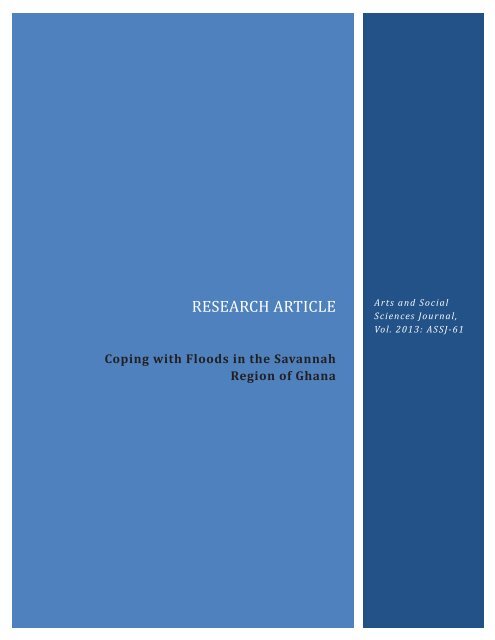
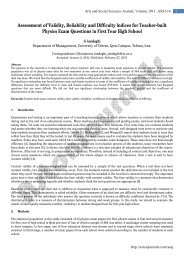
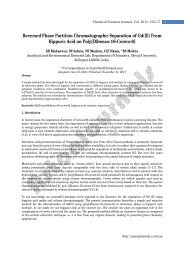
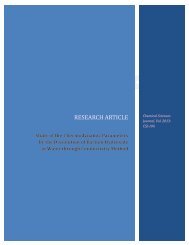
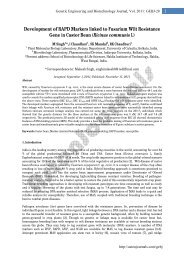
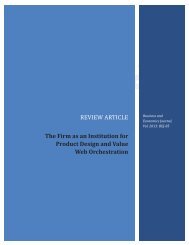
![[1,4]-benzodiazepine-2-one Derivatives as Potent - AstonJournals](https://img.yumpu.com/49117784/1/184x260/14-benzodiazepine-2-one-derivatives-as-potent-astonjournals.jpg?quality=85)
